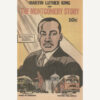“If you stick a knife nine inches into my back and pull it out three inches, that is not progress. Even if you pull it all the way out, that is not progress. Progress is healing the wound, and America hasn’t even begun to pull out the knife.”
–El Hajj Malik El Shabazz (Malcolm X)
Slavery, white pillage, and settler colonialism

It is often said that slavery is America’s original sin. This statement in itself either erases the genocide of First Nations peoples or starts American history at the Revolution, therefore obfuscating much of our settler-colonial origins. It also sets our understanding of America in a Eurocentric lens of Christian redemption and repentance. It would be more useful to say that slavery is the foundation on which we built the very idea of America.
America imagines itself as a frontier house: a well-stocked, nearly self-sufficient, autonomous construct created to advance a manifest destiny. Yet what is manifest destiny if not an imperial idea? While the frontier people who populate this house may not agree with or even be aware of this imperial idea, they continue to serve it, and their worldview is shaped by its needs. In many ways, America is the pinnacle of a specific settler-colonial project, built on stolen land.
When various European empires launched their various colonial projects in the Americas, they shared a fundamental imperial assumption: that land could be owned and Indigenous people could be seen as disposable or could be dominated to suit the needs of empire. The needs of imperialism or empire, whether British, French, or Portuguese, were pretty similar. Broadly speaking, empire wants dominance or power over land, people, wealth, and other nations. A colony is an imperial project insofar as it is created to further the goals of dominance.
The American colonies were an imperial project to extract resources from land stolen from First Nations peoples. It is crucial to understand that the settler’s existence is predicated on preexisting violence. In order for a place to be settled, for the land and people to be pillaged, it first has to be “pacified” through genocide. The first imperial agents sent to a new world are not settlers but explorers who are themselves merely scouts for armies of extraction, domination, and speculation. Settlers were sent to the colonies after the genocide began to further this colonial project by providing labor and management.
The settlers were themselves often refugees and European indigenous populations that were deemed semi-disposable by various European empires. We often forget that everyone is indigenous to somewhere, even our oppressors. Regardless of their personal reason for fleeing Europe, once they became settlers they became a part of the imperial project of domination, speculation, and extraction. Once they were handed land, they were told it was theirs and told that they must defend it. In defending their land they became complicit in the genocidal colonial project even though it preceded their birth and their arrival in the new world.
Imperialism is a positive feedback loop of domination. As the colonial project advanced, more resources were being extracted, which fueled the size and power of European states. This increased the size and scale of European wars, which in turn increased the demand for resources: more labor was needed. The Indigenous populations of North America proved to be difficult to subjugate into forced labor as they were likely to flee plantations and rejoin their Native tribes, which were in active and violent wars of resistance with colonial empires. European indentured servants were little better. For one, it was too easy for light-skinned European indentured servants to run away from their contracts early and pretend to be free Europeans in other settlements. Secondly, the most valuable crops were grown in the American South and the Caribbean, a clime that many Europeans had difficulty adapting to.
Third, and most importantly, after the ruling class of America’s plantation system had to put down a series of intra-racial rebellions such as Bacon’s Rebellion, it became necessary to separate poor European migrant workers and enslaved Africans. European indentured servants and enslaved Africans coming together in solidarity threatened the economic and political system of the pre-revolutionary American South. White supremacy was the solution to this problem. It allowed the payment of a psychological wage, or systemic benefits and privileges, that sent a message to Europeans (increasingly “raced” as white people) that they were better than enslaved Africans, in lieu of the land and wage reforms that the American European immigrant working class had been demanding.
This is the context in which America currently exists and has always existed. Our revolution was not an anti-colonial one in the normal sense. Our revolution was not against empire itself – it was a coup, a desire to begin our own settler-colonial empire within our own tax system.
Dynamics of Whiteness

Whiteness is an elaborate story created not only to justify inequity and enslavement but also to teach poor European immigrants a standard of conduct. White people were told that the system works for them; if they just worked hard and assimilated they could advance up the social ladder. In addition to cultural components made to build internal solidarity with other white people, and by extension the state (Protestantism, English language, work ethic, et cetera), whiteness also set a standard of conduct and achievement.
Whiteness as a standard meant valuing formal Eurocentric education as the prerequisite to economic success; listening to your boss; not speaking out; and using the courts and other institutions when problems arose. This is a concept often called labor discipline, crucial to keeping workers obedient in the inhumane capitalist system. If your boss treated your poorly and the systems for redress didn’t work in your favor, you were prevented from going outside the system by a counter-story of lazy, unruly Black masses. In time, ideas like “white trash” further cemented whiteness as tied to middle-class bourgeois values and “good workers.”
Through this lens, it is clear that white people did not create white supremacy: they are in fact creations of it.
This is the basis for what is now called white middle-class dominant culture: perfectionism, sense of urgency, defensiveness, quantity over quality, worship of the written word, belief in only one right way, paternalism, either/or thinking, power hoarding, fear of open conflict, individualism, belief in one’s own objectivity and the right to comfort, etc. (“Dismantling Racism: A Workbook for Social Change Groups” by Kenneth Jones and Tema Okun, ChangeWork, 2001, see Dismantling Racism Works)
The unnatural standards of whiteness breed a racial anxiety in white communities and inhibit empathetic and emotional supportive family relations by making so many things off limits for conversations.
All told, this creates a culture that lacks many of the spiritually fulfilling traditions and activities that typify ethnic cultures. Again, it is crucial to remember that whiteness is a culture of dominance, not an amalgamation of European cultures. If you were to ask most white people about spaces, habits, and activities that are “white” and spaces that fulfill them emotionally and spiritually, there would be little overlap. White people tend to invest heavily in subcultures, regional cultures, and multicultural events for spiritual and emotional fulfillment.
One of the main drivers of cultural appropriation is the construction of whiteness itself. Whiteness is not merely an amalgamation of European cultural tendencies. This means that whiteness is not a melting pot of French, German, Polish, Russian, Spanish, and Italian cultures. Rather, it is a culture of dominance that exists to both bestow and justify privilege for people perceived by society as white. White ethnic groups had to give up parts of their culture and identity in order to access the privileges of whiteness. Whiteness began to be bought and sold through marketing and advertising, like many other cultural values, during 1950’s consumerism.
As whiteness was being sold through visions of an American dream in subdivision ads and car commercials, consumer capitalism worked to create a cultural deficit in white Americans, a feeling that they didn’t quite “have it all.” Consumer capitalism is then there to fill that deficit, with the next new “modern” thing. This leads to a tendency to mine other cultures for new music, hair styles, and clothing that were previous considered low, uncouth, or unprofessional.
Consumerism, Capital Production and Cultural Appropriation are an unholy trinity of exploitation and marginalization. They provide fertile ground for white America’s obsession with Black pain and trauma. Whether it is in the tragedy porn of shows like The Wire or advocacy organizations’ love of Black tears but aversion to Black power, this obsession forces Black people (and POCs) into permanent victimhood. The permanent victimhood of Black people is one of the reasons that the Black Liberation movement is so viscerally frightening to some white people. Black Liberation’s expressions of joy, rage, and even apathy are beyond the box in which liberal white America puts the Black American other.
–”5 Pillars of Anti-Black White Supremacy” by Aaron Goggans
For Black communities, the lie of Black inferiority, when internalized, creates its own self-limiting beliefs and habits. Racialized stress often leads to horizontal oppressions, as feelings of shame lead Black people to lash out at each other. The lie of Black inferiority, when combined with a disempowering social script that expects “docility” in oppressed Black people and a history of white violence, causes many Black people to be uncomfortable speaking out against white people either because they have been socialized to expect silence from themselves or because they have experienced the violence of speaking out first hand. Equally important, white supremacy and settler colonialism create economic security in Black communities. This forces Black people to have to prioritize acquiring basic economic necessities over activities that might allow for eventual liberation from capitalism, patriarchy, white supremacy, and other forms of domination.
Relationship and building power in coalitions

All of this means that effective coalitions between white and Black people are difficult and tend to be transactional. Transactional relationships are typified by a “what can I get out of this” mentality. Transactional relationships are unable to make systemic change or even effective reforms because they are not strong enough to get people to make any sacrifice. Transactional coalitions tend to fall apart at the first obstacle. They also tend to do more harm than good, as power differentials and resource differences tend to build resentment over time. For instance, Black communities have grown to resent white organizations coming to us with fully planned-out campaigns and asking for our support by telling us how “their” issue affects us.
Reciprocal relationships are far more effective. Reciprocal relationships are typified by a collaborative solidarity informed by honesty, equity, and long term vision. Reciprocal relationships center on real conversations about the needs of both parties and reframe the “asks,” goals, and terms to respect those needs.
Reciprocal coalitions tend to be able to overcome moderate obstacles because all parties see a need to fight and overcome adversity. Reciprocal campaigns are often still susceptible to divide-and-conquer strategies, however. Privileged groups often make deals with those in power who meet their major demands, sometimes at expense of the core demands of marginalized partners. Tipped workers getting left out of minimum wage increases are a great example of this. Even the strongest reciprocal relationships can only achieve reforms of enfranchisement, reforms that bring marginalized communities into current systems.
Transformative relationships are ones that leverage the power of reciprocal relationships to transform the context in which the relationships exist. Transformative relationships transform spaces and endeavors in ways that improve the freedom, joy, power, and self-determination of all parties. Transformative relationships means investing in each party’s capacity so that together you can create a world in which you both thrive. Transformative coalitions are not concerned with making demands of the current system; they are concerned with dismantling the current system and building a new one. Transformative relationships are aware of each other’s past, current context, and visions for the future, and are able to take this into account when plotting a shared course.
Too often, the model of solidarity we use in anti-racism work is based on abusive transactional relationships. Anti-racist solidarity is distinct from other forms of transactional relationships between different communities, like services presented as charity or the tokenism rampant in the performance of white and POC allyship.
There is both a particularly dehumanizing and ineffective model of solidarity in which the transactional nature of the relationship is obfuscated as a repayment of a historic debt. While white people and other communities that benefit from anti-Black white supremacy do have a debt that they must pay, that debt is fundamentally not payable by disempowering themselves through some guilt-ridden attempt to shift their power over to Black people.
To get free we need more power, not less. We need more leaders, not enfeebled followers.
This idea that white people must give up their power is based on a white middle-class and masculine limiting belief in scarcity. It presumes that either power is inherently bad (or at least bad in white people’s hands), or that it is a zero-sum game. Intersectional transformative relationships teach us that power works in abundance. Just as standing in solidarity with my Black Trans siblings requires me to stand in my own transformative non-binary masculine power, not abdicate it, so too must non-Black people stand in their own transformative power. Yet in order for them to do it, they must first discover it and reimagine their identities in a way that accepts my existence and my inherent humanity.
If you are afraid of your power or unable to separate your use of it and your identification with it from the dominance of my Black maleness, then you cannot stand in solidarity with me.
–”What Black Queer Feminism Has Taught Me” by Aaron Goggans
Divesting from White Supremacy and investing in Black Liberation

Stokely Carmichael once said, “If a white man wants to lynch me, that’s his problem, but if he has the power to lynch me, that’s my problem.” The problem with white supremacy is a problem with power. But it’s not who has power, it’s what kind of power they have. White supremacy and settler colonialism give white people power over everyone else in the world, but leave them with little power over their own lives. This is a kind of power so indebted to the master/slave relationship that middle-class white people are able to order any resources they want but unable to provide for their own spiritual wellness and wholeness. They are too used to relying on Black people to raise their children, cook their food, and entertain them to develop an organic culture of their own, and as long as they have the power to force Black people to do it for them, they won’t.
Black people have power and lots of it. We have spiritual power and communal power built out of a long history of resistance. Yet our communities are under attack, and the onslaught of neoliberalism means that we must rely on white institutions and economies in order to survive.
So we live in this constant paradox of not being able to live healthily with each other but being unable to live without each other. Instead we are killing ourselves trying to exist in an abusive relationship that is over four centuries old. In order to untangle ourselves from this abusive relationship we have divest from the system that supports it and invest in something else. We must heal and be whole before we can come together as equals.
For Black people, that has meant divesting from the lies we are told about ourselves and investing in Black community, healing, love, and joy. This why Black Lives Matter DC, for instance, focuses on Black Joy Sunday, supporting Unchained’s Emotional Emancipations, and hosting Black Organizer Dinners. This allows Black people to heal and to decolonize our ideas and relationships with our bodies and ourselves. From these spaces we can build a liberated culture and dual power.
Liberated culture is culture born out of resistance to capitalism, white supremacy, patriarchy, and alienation. Elements of a liberated culture include: value of iterative processes, abundance, generative ideas and processes, being adaptive and conducive to life, transformative, grounded, communal, polycentric, polyrhythmic, nurturing, creative, and centered on manifesting our greatest good.
Dual power is an idea first posited by Lenin and further developed by Marxists, anarcho-socialists, Black nationalists, revolutionary nationalists, and others. At its most basic it is building alternative power. It is building a community’s ability to collect and leverage the resources it needs for its own survival that do not depend on mainstream oppressive structures. In many ways it is Gramsci’s counter-hegemony in practice. It is, to borrow an IWW saying, building a new world in the shell of the old.
Many Movement for Black Lives (M4BL) groups are beginning to formulate plans for building our own version of dual power based in an explicitly Black Queer Feminist liberated culture. These plans are both informed by and birthed in the unapologetically Black spaces that we create and fund with our own salaries, mostly from government and nonprofit work. Many of the vibrant cultural aspects, artwork, chants, songs, and events that have enriched lives and inspired activism come from these spaces.
It should be clear then, how white folks in our network are directly benefiting from this work. The work of the M4BL is providing the keys for white people to dismantle white supremacy.
This means:
- Divesting from unattainable white middle-class standards that teach you self-limiting ideas about the scarcity of power.
- Divesting from ideas of patriarchy and addressing toxic masculinity so that you can organize white people from a place of love, collaboration, and resilience.
- Divesting from systems that feed your body but enfeeble your soul.
- Organizing other white folks (base building) to counter the growing white nationalist and counterrevolutionary backlash. This means building with low-income white folks to bring them into a broad anti-racist coalition that centers Black leadership.
- Divesting from all systems of oppression to build a coalition that is strategically placed to fight for collective liberation.
- Building a new identity based on love and radical inclusion, one that will survive the dismantling of white supremacy and therefore whiteness.
- Investing in Black futures and Black Power so that we can stand together as true partners in social transformation.
- Funding Black organizing to continue providing the energy, vibrancy, and analysis that white people rely on to inform their own work.
Reparations as Dana Practice
In the Buddhist tradition, the teachings are given freely because they are considered priceless; in the Buddhist tradition we also practice dana, or generosity, by making monetary offerings for the teachings. Dana is not payment for goods or services rendered; it is given from the heart. Your generosity is a gift that supports not just the teachers, but also the Sangha, the larger Dharma community, and your own practice.
– See more at: “Meaning of the Pali Word ‘Dana’,” Dharma Wisdom

Interpersonal reparations are a necessary prelude to any hypothetical state-sponsored program. Blacks asking the state to force unwilling white people to pay reparations depends on, and therefore invests in, the state’s ability to commit economic violence on its populace. For reparations to not invest in a new ability of the state to commit economic violence they would have to rely on a preexisting value or structure.
State reparations are also highly unlikely, as the state was created to protect the power relationship that white supremacy was invented to justify. Any variation, like the state taking wealth from corporations or rich families, obfuscates the role of whiteness and the complicity of individual white people.
There is an alternative – a mass movement to dismantle white supremacy, a campaign for reparations in which the campaign itself creates the cultural transformation that allows for the maintenance of those structural transformations that are the ultimate object of the movement.
Reparations should not be seen as merely repaying a material debt. Reparations in the form of giving sustaining gifts to projects of Black queer feminist dual power is a communal ritual, a form of restorative justice, in which White people let go of their power-over in order to sustain their access to their power-with. It is better understood in terms of Buddhist dana than the modern nonprofit industrial complex’s “donation.” It is not charity, nor are you buying something. It is the process in which we can begin to close the wounds of our past and head towards a brighter future. Reparations, when paired with a revolutionary communal praxis of direct action, reflection, analysis building, and healing, is about letting go of whiteness and building something better.







